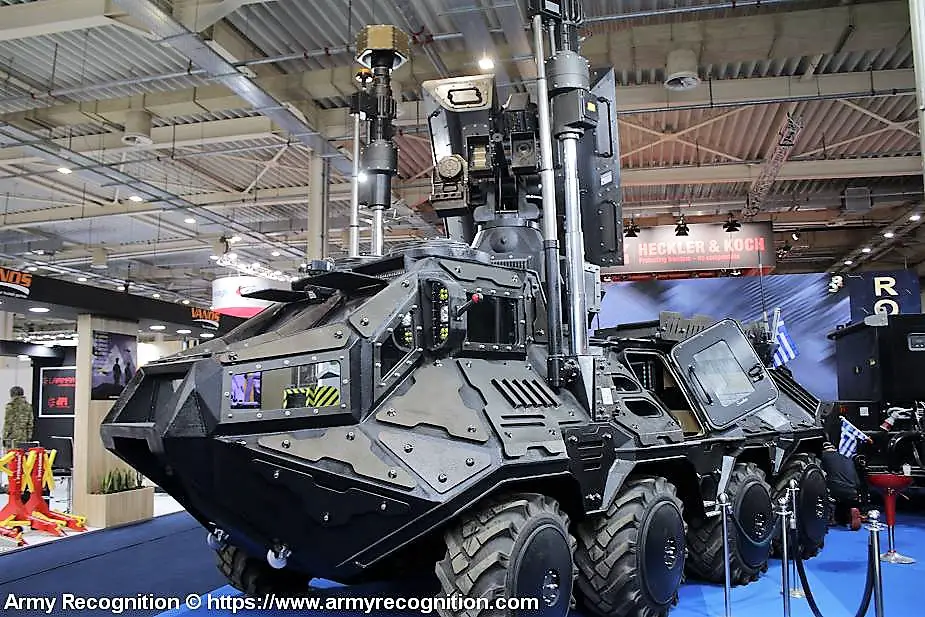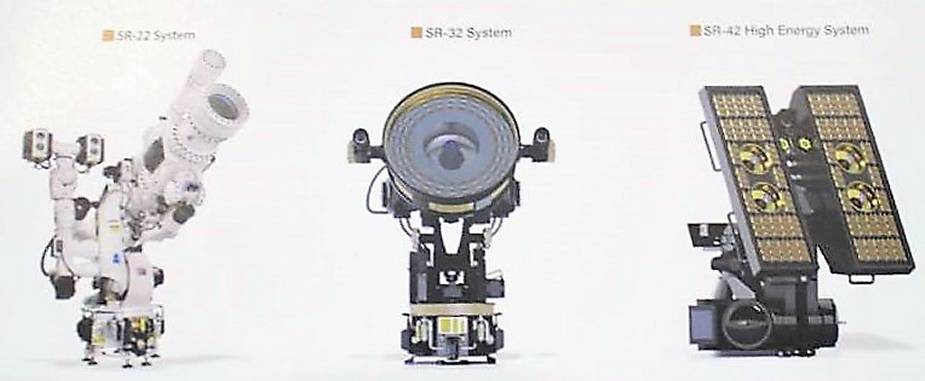All weapon laser systems are hybrid systems using a large range of radiation emissions to reach targets, increasing in this way the energy absorption from the target. The radiation is effective against plastic, rubber, fiberglass, aluminum, armox and hardox steel. The advantages are the low cost of a ‘’shot’’, the instantaneous engagement/reaction (at the speed of light), the ability to deal with drastically changing aerial targets, the adjustable effect on the target (depending on the emitted power and the mission objective), excellent aiming and shooting accuracy at long distances with limited collateral damage, no ammunition storage requirement, and more.
Follow Army Recognition on Google News at this link

Kostas Soukos' Minotaur anti-drone system, obviously based on a highly modified BTR (Picture source: Army Recognition)
Soukos Robots’ laser systems can destroy a target in two different ways: soft kill or hard kill.
Soft kill: by disabling radio control signal receivers, geospatial receivers, cameras (optical-dazzler) and other sensitive electronic sensors. Microwave radiation causes neurological effects on human potential.
Hard kill: the systems use an array of laser beams that converge in one point calculated according to the distance of the target and the relative velocity, resulting in a high temperature increase of the target surface. By using many lower-power laser beams, the system minimizes the effect of atmospheric absorption, diffusion and thermal blooming. The rapid rise of the temperature of the surface on each target causes the melting of armor, piercing of vital systems, igniting fuel tank(s) and battery pack(s), and destroying ammunition. It can also target and destroy the flaps of the targeted drone, rendering its trajectory uncontrollable.
The systems are equipped with passive radar, FLIR sensors, acoustic sensors, cameras, night vision cameras and a laser range finder. The system can be linked to other jamming systems, various radar detection systems and different connection protocols.

Kostas Soukos' laser weapon systems (Picture source: Soukos Robots)
Soukos Robots’ Minotaur anti-drone system
In 2022, Kostas Soukos, a Greek inventor based in Larissa, claimed to have created an anti-drone system that would destroy drones, Tasos Kokkinidis reports in greekreporter.com. Kostas Soukos named his creation “Minotaur”, after the ancient Greek mythical creature portrayed with the head and tail of a bull and the body of a man.
On November 19, 2022, Aegean Monitor posted a tweet unveiling a quite surprising weapon system, writing that it can be both manned and unmanned, can jam communications and fry drones through its laser system. The vehicle is also painted in a special anti-thermal coating. It can also be installed on navy ships. It is worth noting that this program was developed under secrecy in cooperation with the Greek Ministry of Defense, Aegean Monitor writes.
Speaking to public television ERT, Tasos Kokkinidis reports, Soukos described his creation as a robotic platform that carries a large 300 kWh laser unit: “It has the power to “blind”, cause ignition of drones that may violate Greek airspace, and is “invisible” to the thermal detectors of the helicopters”, he added.
The anti-drone system, mounted on a science-fiction-looking 8x8 armored vehicle (obviously a modified Russian BTR), is made exclusively by Greek scientists and engineers in Larissa. “We have proved that Greece is not ‘asleep'”, Soukos said. Our young scientists are producing smart systems that the country urgently needs, he added in reference to the current tensions with Turkey. To date, Greek military authorities have not commented on “Minotaur”, Tasos Kokkinidis wrote.

Kostas Soukos' Minotaur anti-drone system (Picture source: Army Recognition)















